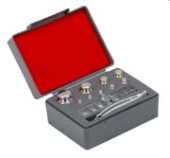Weights
The validity of your work is only as good as the weakest link in your method or procedure. This is why it is imperative that you regularly check the equipment that you depend upon, balances & scales are one such piece of equipment that should be monitored.UKAS CertificationWe only offer UKAS certification through our own in-house metrology laboratory based in Oxford. |  |
| Having a UKAS certificate guarantees that correct calibration
procedures have been followed and that traceability chains back to the
international kg are documented and verified. Our ability to offer
UKAS certification is independently audited by UKAS - United Kingdom Accreditation Service. It is possible to purchase weights with “standard” or “ISO” certification. Providers offering this service have not been audited or approved by a third party, so there is no guarantee as to the validity of the certificate. Note even certification issued by an ISO9001 accredited company is not a guarantee of the validity of a certificate since the organisation is not audited specifically on their technical competence to perform the calibration or the traceability chains back to the International kg verified. Download PDF UKAS guide Find out about the business benefits of UKAS | |
Weight Range :
 |  |  |  |
| Calibration Weights | Test Weights | Weight Sets | Scale Weights |
Uses For Weights
Weights can be used for the following applications :| Adjustment | It
is possible that a balance or scale may stop weighing accurately.
When this occurs it is necessary to correct this error by
activating the adjustment routine on the instrument and then apply a
certified calibration weight to perform the correction |
| Calibration | To
assess the performance of the balance or scale and prove traceability
back to National and International standards. It is necessary to
calibrate the instrument using a certified calibration weight. |
| Test | Balances and scales should be checked to ensure the calibration has not drifted and it is still weighing accurately. This is a routine process that should be carried out on a daily or before use basis |
Selecting the Class of Weights
This very much depends on how you will use the weights, and the specification of the balance or scale. However as a rule of thumb you can use the following:E2 Class Weights : Analytical Balances (0.1mg readability and more accurate)
F1 Class Weights : Milligram & Top Pan Balances (0.1g and more accurate)
M1 Class Weights : Compact Balances and Industrial Scales ( 1g and less accurate)
Selecting the Denomination of Weights
Again this depends on the application you are using the weight for, but for test purpose as described above:We recommend a weight at approximately the capacity of the scale and again where you most typically weigh on the balance to perform the daily or before use check. To perform a monthly linearity check select 3 - 4 test points which cover the full range of the instrument.

